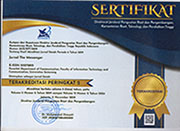A Communications Strategy of the Malaysian Research Universities to add Value
Abstract
Keywords
Full Text:
PDFReferences
Abdullah, Z. S. M., & Nordin, Y. A. A. (2013). Building a Unique Online Corporate Identity. Marketing Intelligence & Planning, 31(5), 451 471.
Abratt, R., & Keyn, N. (2012). Corporate Identity, Corporate Branding and Corporate Reputations: Reconciliation and Integration. European Journal of Marketing, 46(7), 1048 1063.
Baker, B., & Boyle, C. (2009). The Timeless Power of Storytelling. Journal of Sponsorship, 3(1), 79 87.
Barnes, E. (2003). What s Your Story. Harvard Management Communication Letter, 6(7), 3 5.
Brennan, N. M., & Guillamon-Saorin, A. P. E. (2009). Impression Management: Developing and Illustrating a Scheme of Analysis for Narrative Disclosures: A Methodological Note. Accounting, Auditing & Accountability Journal, 22(5), 789 832.
Brown, T. J., Dacin, P. A., Pratt, M. G., & Whetten, D. A. (2009). Identity, Intended Image, Construed Image, and Reputation: an Interdisciplinary Framework and Suggested Terminology. Journal of the Academy of Marketing Science, 34(2), 99 106.
Chun, R., & Davies, G. (2001). E-reputation: The Role of Mission and Vision Statements in Positioning Strategy. Journal of Brand Management, 8(4), 315 333.
Collins, D. (2013). In search of Popular Management: Sense Making, Sense Giving and Storytelling in the Excellence Project. Culture and Organization, 19(1), 42 61.
Cunliffe, A. L., Luhman, J. T., & Boje, D. M. (2004). Narrative Temporality: implications for Organisational Research. Organisation Studies, 25(2), 261 286.
Desmidt, S., & Prinzie, A. A. (2008). The Impact of Mission Statements: An Empirical Analysis from a Sense-making Perspective. Academy of Management Proceedings, 1 6.
Dowling, G. P. M. (2006). Communicating Corporate Reputation through Stories. California Management Review, 49(1), 82 100.
Dowling, G. P. M. (2012). Corporate Reputation: Built In or Bolted On? California Management Review, 54(2), 25 34.
Driscoll, C. & McKee, M. (2007). Restorying a Culture of Ethical and Spiritual Values: a Role for Leader Storytelling. Journal of Business Ethics, 73(2), 205 217.
DuBrin, A. J. (2010). Impression Management in the Workplace Research, Theory and Practice. New York: Routledge.
Fetscherin, M., & Usunier, J. (2012). Corporate Branding: an interdisciplinary Literature Review. European Journal of Marketing, 46(5), 733 753.
Forster, E. M. (1963). 'The story' and The plot , in McQuillan, M. (Ed.). The Narrative Reader, 44 46.
Gabriel, Y. (1991). On organisational stories and myths: why it is easier to slay a dragon than kill a myth. International Sociolog, 6(4), 427 442.
Gardner, W. L., & Martinko, M. J. (2004). Impression Management in Organizations. Journal of Management, 14(2), 321 338.
Gill, R. (2011). An Integrative Review of Storytelling: using Corporate Stories to strengthen Employee engagement and Internal and External Reputation. PRism, 8(1). Retrieved from http://www.prismjournal.org/homepage.html
Harrison, K. (2007). Strategic Public Relations, A Practical Guide to Success. Perth: Century Consulting.
Herskovitz, S., & Crystal, M. (2010). The Essential Brand Personal: Storytelling and Branding. Journal of Business Strategy, 31(3), 21 28.
Hladchenko, M. (2013). Mission Statement: A component of the Strategic Management of University (on the example of German Universities). New Educational Review, 31(1), 229 240.
Ingenhoff, D., & Fuhrer, T. (2010). Positioning and Differentiation by Using Brand Personality Attributes. Corporate Communications: An International Journal, 15(1), 83 101.
Janssen, S., Dalfsen, C. K. A. V., Hoof, J. J. V., & Vuuren, M. V. (2012). Balancing uniqueness and similarity: A Content Analysis of Textual characteristics in Dutch Corporate stories. Public Relations Review, 38(1), 32 39.
Jones, E. E., & Pittman, T. S. (1982). "Toward a General Theory of Strategic Self-presentation", in Suls, J. (Ed.), Psychological Perspectives on the Self.
Kaye, M. (1996). Myth-makers and Story-tellers. Melbourne: Business and Professional Publishing.
King, Findlay, & Ahrens. (2010). International Student Mobility Literature Review.
Krippendorff, K. (2004). Content Analysis: An Introduction to Its Methodology. London: Sage.
Kuenssberg, S. (2011). The Discourse of Self-presentation in Scottish University Mission Statements. Quality in Higher Education, 17(3), 279 298.
Larsen, M. H. (2000). "Managing the Corporate Story , in Schultz, M., Hatch, M. J., & Larsen, M. H. (Eds), The Expressive Organisation.
L Etang, J. (2008). Public Relations: Concepts, Practice and Critique. London: Sage.
Mansi, Pandey, & Ghauri. (2017). CSR Focus in the Mission and Vision statements of Public Sector Enterprises: evidence from India. Managerial Auditing Journal, 32(4 5), 356 377.
Marshall, J., & Adamic, M. (2010). The Story is the Message: shaping Corporate Culture. Journal of Business Strategy, 31(2), 18 23.
Martin, J., Feldman, M. S., Hatch, M. J., & Sitkin, S. (1983). The Uniqueness Paradox in Organizational Stories. Administrative Science Quarterly, 28(3), 438 453.
Marzec, M. (2007). Telling the Corporate Story: vision into action. Journal of Business Strategy, 28(1), 26 36.
McLellan, H. (2006). Corporate Storytelling Perspectives. Journal for Quality and Participation, 29(1), 17 20.
Merkl-Davis, D. M. (2011). A Conceptual Framework of Impression Management: New Insights from Psychology, Sociology, and Critical Perspectives, 41(5), 415 431.
Meyer, R. J. (1995). Stories to Teach and Teaching to Story: The use of Narrative in Learning to Teach. Language Arts, 72(4), 276 286.
Mohan, T., McGregor, H., Saunders, S., & Archee, R. (2008). Communicating as Professionals. Melbourne: Thomson.
Morgan, S. & Dennehy, R. (1997). The Power of Organisational Storytelling: a Management Development Perspective. Journal of Management Development, 16(7).
Olutayo, O. B., & Melewar, T. C. (2007). Understanding the meaning of corporate identity: a conceptual and semiological approach. Corporate Communications: An International Journal, 12(4), 414 432.
Otubanjo, O. (2012). Embedding Theory in Corporate Identity through the Social Construction Lens. International Journal of Business and Management, 7(22).
Pearce, J. (1982). The Company Mission as a Strategic Tool. MIT Sloan Management Review, 23, 15 24.
Prusak, L. (2001). Storytelling, Passport to the 21st Century. Retrieved from www.creatingthe21stcentury.org/larry
Rahman, S. (2012). Impression Management Motivations, Strategies and Disclosure Credibility of Corporate Narratives. Journal of Management Research, 4(3), 1 14.
Rekom, J. V. (1997). Deriving an Operational measure of Corporate Identity. European Journal of Marketing, 31(5).
Riel, C. B. M. V. (2000). Corporate Communication orchestrated by a Sustainable Corporate Story", in Schultz, M., Hatch, M. J., & Larsenj, M. H. (Eds), The Expressive Organisation. Oxford: Oxford University Press.
Riel, C. B. M. V., & Fombrun, C. J. (2007). Essentials of Corporate Communication: Implementing Practices for Effective Reputation Management. Routledge.
Roper, S., & Fill, C. (2012). Corporate Reputation, Brand and Communication. Pearson.
Schleicher, T. (2012). When is Good News really Good News? Accounting and Business Research, 42(5), 547 557.
Schlender, B. R., & Weigold, M. F. (1992). Interpersonal Processes involving Impression Regulation and Management. Annual Review of Psychology, 43(1), 133 168.
Schmeltz, L. (2014). Identical or Just Compatible? The Utility of Corporate Identity Values in Communicating Corporate Social Responsibility. International Journal of Business Communication, 51(3), 234 258.
Schniederjans, D., Cao, E., & Schniederjans, M. (2013). Enhancing Financial Performance with Social Media: An Impression Management Perspective. Decision Support Systems, 55, 911 918.
Simmons, G. (2007). I-branding: developing the Internet as a Branding Tool. Marketing Intelligence & Planning, 25(6), 544 562.
Sole, D., & Wilson, G. (2002). Storytelling in Organizations: The Power and Traps of using Stories to Share knowledge in organizations. LILA Harvard Graduate School of Education, 1 12. Retrieved from http://www.providersedge.com/docs/km_article/Storytelling_in_Organizations.pdf
Spear, S. (2017). Impression Management Activity in Vision, Mission, and Values Statements: A Comparison of Commercial and Charitable Organizations. International Studies of Management & Organization, 47(2), 159 175. Retrieved from http://dx.doi.org/10.1080/00208825.2017.1256165
Spear, S., & Roper, S. (2013). Using Corporate Stories to build the Corporate Brand: An Impression Management perspective. Journal of Product & Brand Management, 22(7), 491 501.
Suvatjis, J., Chernatony, L. D., & Halikias, J. (2012). Assessing the Six-Station Corporate Identity Model: A Polymorphic Model. Journal of Product & Brand Management, 21(3), 153 166.
Taliaferro, J. D., & Ruggiano, N. (2010). It s Human beings talking to One-another : The role of Relationship building in Non-profit. Lobbying PRism, 7(2). Retrieved from http://www.prismjournal.org/fileadmin/Praxis/Files/Journal_Files/Taliaferro_Ruggiano.pdf
Wilkins, A. L., & Thompson, M. (1991). On getting the Story Crooked (and Straight). Journal of Organizational Change Management, 4(3), 18 26.
Woodside, A. G., & Megehee, C. (2010). Travel Storytelling Theory and Practice. Anatolia, 20, 86 99.
Woodside, A. G. (2010). Brand-consumer Storytelling Theory and Research: introduction to a Psychology and Marketing special issue. Psychology and Marketing, 27(6), 531 540.
Young, J. A., Gardner, W. L., & Gilbert, F. W. (1994). Impression Management Techniques in Marketing Channels: A Theoretical Perspective and Research Agenda. Journal of Marketing Theory and Practice, 29 38.
Zulkifli, A. L. (2013). Pengaruh Visi dan Misi terhadap Pembentukan satu Dasar dan Amalan Penerbit University: satu Analisis. Proceeding of the International Conference on Social Science Research 2013.
DOI: http://dx.doi.org/10.26623/themessenger.v11i1.1211
Refbacks
- There are currently no refbacks.
Copyright (c) 2019 Jurnal The Messenger
View My Stats [Jurnal The Messenger] is an International Scientific Journal, Published by the Department of Communication, Faculty of Information Technology and Communication, Universitas Semarang (Central Java, Indonesia). It is licensed under a Creative Commons Attribution 4.0 International License.



_11.jpg)




_BARCODE.jpg)
_BARCODE1.jpg)


5.png)










2.png)





